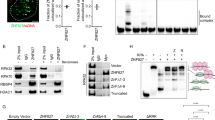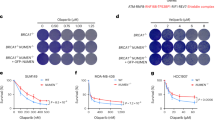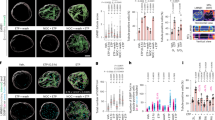Abstract
DNA repair is essential in maintaining genome integrity and defects in different steps of the process have been linked to cancer and aging. It is a long lasting question how DNA repair is spatially and temporarily organized in the highly compartmentalized nucleus and whether the diverse nuclear compartments regulate differently the efficiency of repair. Increasing evidence suggest the involvement of nuclear pore complexes in repair of double-strand breaks (DSBs) in yeast. Here, we show that the human nucleoporin 153 (NUP153) has a role in repair of DSBs and in the activation of DNA damage checkpoints. We explore the mechanism of action of NUP153 and we propose its potential as a novel therapeutic target in cancers.
This is a preview of subscription content, access via your institution
Access options
Subscribe to this journal
Receive 50 print issues and online access
$259.00 per year
only $5.18 per issue
Buy this article
- Purchase on SpringerLink
- Instant access to full article PDF
Prices may be subject to local taxes which are calculated during checkout




Similar content being viewed by others
References
Jackson SP, Bartek J . The DNA-damage response in human biology and disease. Nature 2009; 461: 1071–1078.
Misteli T, Soutoglou E . The emerging role of nuclear architecture in DNA repair and genome maintenance. Nat Rev Mol Cell Biol 2009; 10: 243–254.
Bartek J, Lukas J . DNA damage checkpoints: from initiation to recovery or adaptation. Curr Opin Cell Biol 2007; 19: 238–245.
Lisby M, Mortensen UH, Rothstein R . Colocalization of multiple DNA double-strand breaks at a single Rad52 repair centre. Nat Cell Biol 2003; 5: 572–577.
Nagai S, Dubrana K, Tsai-Pflugfelder M, Davidson MB, Roberts TM, Brown GW et al. Science 2008; 322: 597–602.
Oza P, Jaspersen SL, Miele A, Dekker J, Peterson CL . Mechanisms that regulate localization of a DNA double-strand break to the nuclear periphery. Genes & Development 2009; 23: 912–927.
Loeillet S, Palancade Bt, Cartron M, Thierry As, Richard G-F, Dujon B et al. Genetic network interactions among replication, repair and nuclear pore deficiencies in yeast. DNA Repair 2005; 4: 459–468.
Bermejo R, Capra T, Jossen R, Colosio A, Frattini C, Carotenuto W et al. The Replication Checkpoint Protects Fork Stability by Releasing Transcribed Genes from Nuclear Pores. Cell 2011; 146: 233–246.
Soutoglou E, Dorn JF, Sengupta K, Jasin M, Nussenzweig A, Ried T et al. Nat Cell Biol 2007; 9: 675–682.
Weinstock DM, Nakanishi K, Helgadottir HR, Jasin M . Assaying Double-Strand Break Repair Pathway Choice in Mammalian Cells Using a Targeted Endonuclease or the RAG Recombinase. Methods Enzymol 2006; 409: 524–540.
Miller KM, Tjeertes JV, Coates J, Legube G, Polo SE, Britton S et al. Human HDAC1 and HDAC2 function in the DNA-damage response to promote DNA nonhomologous end-joining. Nat Struct Mol Biol 2010; 17: 1144–1151.
Rass E, Grabarz A, Plo I, Gautier J, Bertrand P, Lopez BS . Role of Mre11 in chromosomal nonhomologous end joining in mammalian cells. Nat Struct Mol Biol 2009; 16: 819–824.
Guirouilh-Barbat Je, Huck S, Bertrand P, Pirzio L, Desmaze C, Sabatier L et al. Molecular Cell 2004; 14: 611–623.
Xie A, Hartlerode A, Stucki M, Odate S, Puget N, Kwok A et al. Molecular Cell 2007; 28: 1045–1057.
Yoshida M, Horinouchi S . Trichostatin and Leptomycin: Inhibition of Histone Deacetylation and Signal-Dependent Nuclear Export. Ann N Y Acad Sci 1999; 886: 23–35.
Walther TC, Fornerod M, Pickersgill H, Goldberg M, Allen TD, Mattaj IW . The nucleoporin Nup153 is required for nuclear pore basket formation, nuclear pore complex anchoring and import of a subset of nuclear proteins. EMBO J 2001; 20: 5703–5714.
Moudry P, Lukas C, Macurek L, Neumann B, Heriche J-K, Pepperkok R et al. Nucleoporin NUP153 guards genome integrity by promoting nuclear import of 53BP1. Cell Death Differ 2011 (e-pub ahead of print 11 November 2011; doi:10.1038/cdd.2011.150).
Bunting SF, Callén E, Wong N, Chen H-T, Polato F, Gunn A et al. 53BP1 Inhibits Homologous Recombination in Brca1-Deficient Cells by Blocking Resection of DNA Breaks. Cell 2010; 141: 243–254.
Bouwman P, Aly A, Escandell JM, Pieterse M, Bartkova J, van der Gulden H et al. 53BP1 loss rescues BRCA1 deficiency and is associated with triple-negative and BRCA-mutated breast cancers. Nat Struct Mol Biol 2010; 17: 688–695.
Mochan TA, Venere M, DiTullio RA, Halazonetis TD . 53BP1 and NFBD1/MDC1-Nbs1 Function in Parallel Interacting Pathways Activating Ataxia-Telangiectasia Mutated (ATM) in Response to DNA Damage. Cancer Res 2003; 63: 8586–8591.
Lee J-H, Goodarzi AA, Jeggo PA, Paull TT . 53BP1 promotes ATM activity through direct interactions with the MRN complex. EMBO J 2010; 29: 574–585.
Noon AT, Shibata A, Rief N, Lobrich M, Stewart GS, Jeggo PA et al. 53BP1-dependent robust localized KAP-1 phosphorylation is essential for heterochromatic DNA double-strand break repair. Nat Cell Biol 2010; 12: 177–184.
Minter-Dykhouse K, Ward I, Huen MSY, Chen J, Lou Z . Distinct versus overlapping functions of MDC1 and 53BP1 in DNA damage response and tumorigenesis. J Cell Biol 2008; 181: 727–735.
Matsuoka S, Ballif BA, Smogorzewska A, McDonald ER, Hurov KE, Luo J et al. ATM and ATR Substrate Analysis Reveals Extensive Protein Networks Responsive to DNA Damage. Science 2007; 316: 1160–1166.
Palancade B, Liu X, Garcia-Rubio M, Aguilera As, Zhao X, Doye Vr . Nucleoporins Prevent DNA Damage Accumulation by Modulating Ulp1-dependent Sumoylation Processes. Mol Biol Cell 2007; 18: 2912–2923.
Soutoglou E, Misteli T . Activation of the cellular DNA damage response in the absence of DNA lesions. Science 2008; 320: 1507–1510.
Reddy KL, Singh H . Using molecular tethering to analyze the role of nuclear compartmentalization in the regulation of mammalian gene activity. Methods 2008; 45: 242–251.
Acknowledgements
We thank Amélie Weiss, Laure Froidevaux and Audrey Furst for excellent technical assistance. The GFP-NUP153 vector was provided by Ian Ellenberg (EMBL, Heidelberg). We are grateful to Zita Nagy and Tibor Pankotai for critical reading of the manuscript. C.L. is supported by the Région Alsace. The research in E.S. lab is funded by CNRS, ANR, INCA and HFSP. We thank the imaging center of IGBMC and particularly Marc Koch for the help with the multi photon laser experiments.
Author information
Authors and Affiliations
Corresponding author
Ethics declarations
Competing interests
The authors declare no conflict of interest.
Additional information
Supplementary Information accompanies the paper on the Oncogene website
Supplementary information
Rights and permissions
About this article
Cite this article
Lemaître, C., Fischer, B., Kalousi, A. et al. The nucleoporin 153, a novel factor in double-strand break repair and DNA damage response. Oncogene 31, 4803–4809 (2012). https://doi.org/10.1038/onc.2011.638
Received:
Revised:
Accepted:
Published:
Issue Date:
DOI: https://doi.org/10.1038/onc.2011.638
Keywords
This article is cited by
-
Functional interplay between TFIIH and KAT2A regulates higher-order chromatin structure and class II gene expression
Nature Communications (2019)
-
C/EBPβ enhances platinum resistance of ovarian cancer cells by reprogramming H3K79 methylation
Nature Communications (2018)
-
TIRR regulates 53BP1 by masking its histone methyl-lysine binding function
Nature (2017)
-
Damage-induced lncRNAs control the DNA damage response through interaction with DDRNAs at individual double-strand breaks
Nature Cell Biology (2017)
-
DNA end resection requires constitutive sumoylation of CtIP by CBX4
Nature Communications (2017)



